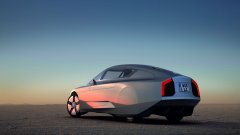OSRAM's LED technology contributes to the energy efficiency of Volkswagen's L1 concept car presented at the Frankfurt International Motor Show (IAA). The vehicle, which according to Volkswagen can go into production in 2013, has headlights that are equipped with new OSRAM Joule JFL2 LED systems and matching reflectors. The LED modules take care of the dipped and main beam functions and consume far less energy than conventional headlamps. Joule JFL2 LED modules will be introduced in production in early 2010 and can then be included in new vehicle models easily and across multiple platforms.
 With a power input of only 19 watts per dipped light, the L1’s lighting is far more energy-efficient today
than conventional headlamp solutions.
With a power input of only 19 watts per dipped light, the L1’s lighting is far more energy-efficient today
than conventional headlamp solutions.
One key to the unparalleled energy-efficiency of Volkswagen's L1 are OSRAM's highly efficient Joule JFL2 LED modules, which are used in the front headlights. What is special about them is that the dimmable LED light sources are responsible for the important dipped and main beam functions. Each of the only five centimetre high headlights requires a total of three modules. Two provide the ECEcompliant (Economic Commission for Europe) main light and one the high beam. Apart from the high performance diodes, this is made possible by the reflectors Volkswagen has developed, which shed an ideal light on the road and are therefore the perfect complement to the JFL2 LED modules.
Thomas Reiners, Director of Application Technology for special lighting at OSRAM is confident that "Compact and efficient LED sources will be mandatory for low consumption and electric vehicles in the future in order to achieve the car industry's CO2 objectives. A dipped beam headlight with these light sources will use less than 15 watts and therefore save 40 watts of power input per vehicle side compared with a halogen solution".
With a power input of only 19 watts per dipped beam, the one-litre car's lighting is far more energyefficient today than conventional headlight solutions, in which mostly halogen lamps with 55 watts are used. Even Xenon lamps at only 35 watts of input use 20% more energy on dipped lights (95% of nighttime driving) than two Joule JFL2 LED modules.
"Energy efficiency and ease of integration were good reasons to rely on LED solutions for headlights on our one-litre car. This technology is just as forward-looking as our vehicle", says Henning Kiel, lighting engineer at Volkswagen. Replaceable LED light sources represent a genuine alternative to the lamps already available in the car industry. "They can bring about significant benefits both for end customers as well as during headlamp and vehicle production", says Christian Meier, OSRAM Product Manager Joule LED systems.
OSRAM LED solutions not only show their strengths in terms of efficiency. With a lifetime that normally exceeds that of a vehicle plus their considerable robustness against shocks and vibration, they are far less maintenance-intensive than conventional lamps. From early 2010, Joule JFL2 LED modules will be available to light other vehicles with economical diodes, too.
Joule JFL2 LED modules were developed in collaboration between OSRAM Automotive Lighting and the LED specialist OSRAM Opto Semiconductors. Together these companies develop solutions for the automotive industry from individual LEDs to standard LED systems such as Joule. The L1's headlights are the result of a joint project by Volkswagen and OSRAM. The lighting manufacturer has developed an even more economical version of the Joule JFL2 LED module for them, which uses 14 watts in the standard configuration. Volkswagen designed the reflectors, which enable legally compliant headlights to be implemented with the latest lighting technology.